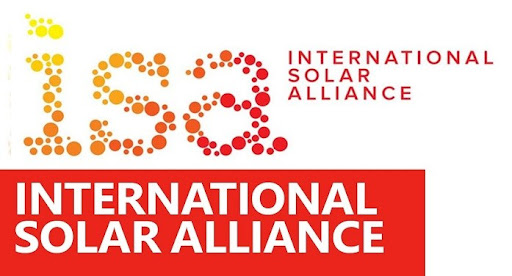International Solar Alliance(ISA) at a Crossroads
Syllabus:
GS-3:
Important International Institutions
Focus:
ISA, launched by India to promote solar energy, has fallen short in delivering large-scale solar projects in developing nations. With significant challenges and a lopsided solar adoption globally, ISA’s role in promoting equitable solar growth and supporting the Global South has come under scrutiny.
Background and Establishment of ISA:
- The International Solar Alliance (ISA) was launched by India, led by Prime Minister Narendra Modi, alongside France during the 2015 Paris Climate Conference.
- This unique initiative aimed to accelerate solar energy adoption, particularly in developing nations, and was intended as a key move to empower the Global South.
- ISA has now evolved into an intergovernmental organisation with over 110 member countries, aiming to overcome barriers to solar energy adoption and facilitate a global energy transition.
Important Solar Energy Initiatives of India:
- National Solar Mission
- Part of India’s National Action Plan on Climate Change.
- Aims to position India as a global leader in solar energy by creating favourable policies for rapid solar adoption nationwide.
- INDC Targets
- India targets 100 GW grid-connected solar power by 2022.
- Aligned with India’s Intended Nationally
- Determined Contributions (INDCs) to achieve 40% electric power capacity from non-fossil sources.
- Aims to reduce emission intensity of GDP by 33–35% from 2005 levels by
- Supporting Government Schemes
- Solar Park Scheme: Establishes large-scale solar parks to centralise solar power generation.
- Canal Bank & Canal Top Scheme: Utilises canal surfaces for solar panels to save land and water resources.
- Bundling Scheme: Integrates solar with other energy sources for cost-effective energy supply.
- Grid-Connected Solar Rooftop Scheme: Promotes solar rooftop installations across residential and commercial sectors.
- First Green Hydrogen Mobility Project
- NTPC Renewable Energy Ltd (REL) collaborates with the Union Territory of Ladakh.
- Plans to produce green hydrogen through water electrolysis powered by solar/wind energy, marking a step toward a low-carbon energy future.
Key facts about International Solar Alliance (ISA):
- First Ratification: Denmark became the first country to ratify the amended ISA Framework Agreement, allowing all UN member states to join.
- Launch & Vision: Initiated in 2015 at COP21 by India and France to expand solar energy use, ISA is a treaty-based body headquartered in India.
- Members & Mission: With over 100 countries, ISA aims to provide energy access and promote sustainable solar use globally.
- Key Objectives: Increase solar investments, enable cost-effective solar tech, and support countries like LDCs and SIDS in low-carbon growth.
- Priority Areas: ISA focuses on analytics, advocacy, capacity building, programmatic support, and readiness activities to drive solar adoption.
- Assembly Role: The ISA Assembly, its main decision-making body, oversees objectives, budget approval, and program implementation.
ISA’s Underwhelming Impact on Solar Adoption:
- ISA’s goal was not to develop projects itself but to act as a facilitator to aid countries in overcoming financial, technological, and regulatory obstacles to solar deployment.
- Despite nearly a decade since its inception, ISA has limited achievements in project facilitation; the first significant project, a 60 MW solar plant in Cuba, is still pending.
- Numerous countries in Latin America and Africa are at various preparatory stages, yet ISA’s influence on expediting solar project implementation remains modest.
The Dominance of China and Developed Countries:
- Global solar energy adoption has surged, with a 20% annual growth rate and a 30% rise in 2023 alone; however, most installations are concentrated in a few countries.
- China leads by a significant margin, accounting for 62% of global solar capacity additions in 2023, while the top 10 countries represent over 95% of total installations.
- Less than 2% of solar capacity additions occur in Africa, despite the region housing nearly half of the global population without electricity access.
Challenges in Small Developing Nations:
- Developing countries, especially in Africa, face substantial entry barriers such as lack of experience with large-scale solar projects, limited local developers, and inadequate regulatory frameworks.
- ISA has tried to address these issues by setting up Solar Technology and Applications Resource (STAR) centres to build local expertise and establish policy stability.
- Despite these initiatives, ISA’s influence has been limited due to underfunding, understaffing, and minimal involvement from its Indian liaison ministry.
Solar Energy’s Crucial Role in Climate Goals:
- Solar energy is pivotal for achieving global net-zero emissions by 2050, given its rapid growth and potential as the cheapest energy source in sunny regions.
- While solar capacity is projected to grow significantly to meet climate goals, developing regions remain underrepresented in solar adoption.
- The disparity in solar manufacturing, with 80% of the industry based in China, exacerbates barriers for smaller markets and hinders the broader goals set by ISA.
India’s Leadership and Strategic Importance:
- India’s role in ISA serves as a critical element of its outreach to the Global South, particularly African nations, showcasing its leadership and commitment to sustainable development.
- Although ISA is a multilateral organisation, it is headquartered and funded largely by India, underscoring India’s responsibility for its success.
- The ISA’s performance impacts India’s diplomatic reputation and its claim to lead the Global South; however, limited progress on ISA’s initiatives has dampened excitement for solar energy in countries needing affordable, reliable power.
Conclusion:
ISA was established to aid the global energy transition, especially in developing regions. However, limited project facilitation and concentration of solar capacity in a few countries raise concerns about ISA’s efficacy. Addressing these challenges is essential for ISA to fulfil its original promise.
Source: IE
Mains Practice Question:
Critically evaluate the International Solar Alliance’s (ISA) role in promoting solar energy across developing nations. Discuss the challenges ISA faces and the measures needed to achieve its objectives for an equitable global solar transition.
Associated Article:
https://universalinstitutions.com/seventh-international-solar-alliance-assembly-opens-in-new-delhi/




